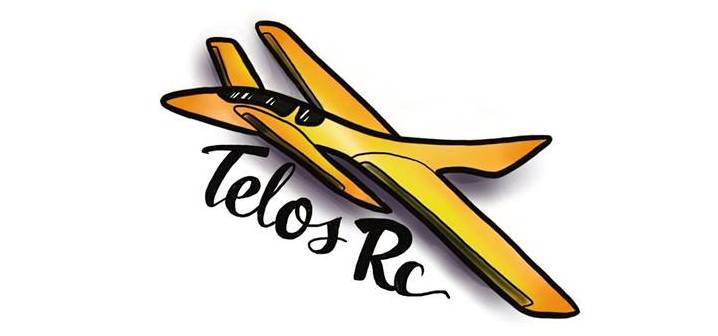Categories of RC gliders and sailplanes.
There are several different categories of radio control glider, as well as a large diversity of model designs ranging from general sport gliders to expensive carbon racing ones to large scale vintage sailplanes. Below are some examples of and brief introductions to the more popular types…
General sport gliders.
These come in a large variety of shapes and sizes and are suited to flat field flying with assisted launch, or the very popular sector of slope soaring.
Typically three channel (rudder, aileron & elevator), sport gliders can handle a variety of conditions and are, usually, aerobatically capable. Sport rc gliders can be non-scale or scale, although many scale gliders of this type are labelled as ‘aerobatic’ rather than ‘sport’.
Construction, as with any rc aircraft, can be traditional balsa and ply or foam such as the popular Multiplex Cularis, shown below, or GRP (glass reinforced plastic aka fibreglass). This latter material is very common in rc glider construction.
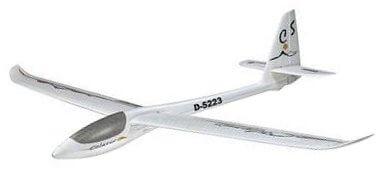
Above: Multiplex have produced some nice foamie gliders, like this Cularis.
Hand launched gliders
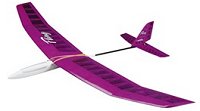
Gliders that are specifically designed to be thrown upwards from a strong hand launch are generally smaller, to make them more manageable. You might see them referred to as chuckies.
A simple two channel example is the Great Planes Fling, shown right, although owner feedback about this particular glider hasn’t been great. Gliders like this one can also be launched with a simple ‘high-start’ launching system (catapult / bungee) so if your throws aren’t quite strong enough then you can still get airborne. But with the right throwing technique and strength a hand launched glider can easily reach an adequate altitude without any external aids.
Once launched, either by a throw or catapult system, flight duration is achieved by using thermals and wind to keep the glider aloft.
Discus Launch Gliders (DLGs).
Following on from the standard hand launch gliders mentioned above, a Discus Launch Glider is a newer breed of rc glider that’s become very popular with flat-field flyers.
A DLG has a specially designed wingtip handle (a strong pin running vertically through the wing) that is held between index and middle finger. The pilot spins in a 360 degree circle and launches the glider upwards on exiting the spin, just like a field athlete launches a discus (hence the name DLG…).
You don’t need to be strong because the force needed to power the glider upwards is generated during your spin, and then the design of the glider aids the steep climb.
With the right technique a Discus Launch Glider can reach a surprising height. Once the glider has leveled out after its vertical climb, your thermal-seeking can commence.
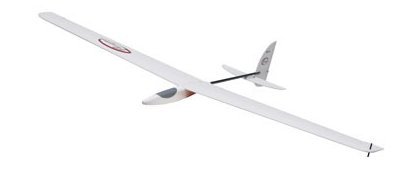
The big advantage with a DLG, and indeed a normal hand launch glider, is that you don’t need to be on a hilltop or in an area large enough to take a long bungee/Hi-Start system. A DLG can be launched from a relatively small space, as it goes vertically upwards.
Thermal soarers.
RC sailplanes that are intended for thermal soaring tend to have larger wingspans, up to 4 meters for the serious competition models. Their construction is kept as lightweight as possible and they have a low wing loading, this combination keeps their glide rate (vertical descent) to an absolute minimum.
There’s a definite skill to thermal soaring; if the pilot can’t successfully locate the thermals then the glider won’t stay airborne for any great length of time. That said, a thermal soarer will out fly a sport glider (time aloft) under the same conditions, simply because of its better glide rate.
A fairly typical ‘pod and boom’ type rc thermal soarer is shown below:
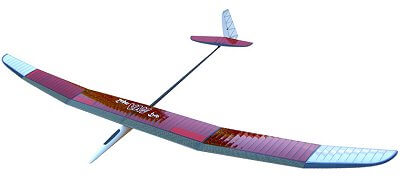
Combat RC gliders.
Combat gliders are generally much smaller than traditional soarers and are typically made from EPP (Expanded Polypropylene) foam, a material that’s incredibly tough and resilient to damage, making the gliders very durable. The tail feathers can be sheet balsa or, more commonly, fluted polypropylene sheet (eg ‘Corflute’), a very bendy and crash-resistant material.
EPP combat gliders are commonly covered in reinforced tape to add strength, and then coloured tape to finish. All this tape also adds to the durability. Other ways of finishing them include paint and low-heat iron on covering film.
The idea with combat gliding is to fly as a group and try to knock your opponent’s glider out of the air. Because the EPP rarely gets damaged, it’s quite safe to fly straight into another glider at full speed!
My EPP combat glider is shown below, an ‘Eraser‘ from Canterbury Sailplanes of New Zealand:
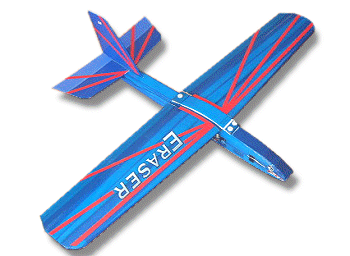
Combat gliders are a great deal of fun, but even if you can’t get a group together flying one on your own is equally exhilarating. Because of their general design they can be very maneuverable indeed and in the right conditions can be flown fast and aerobatically. Highly recommended for some low-worry slope soaring fun!
Scale RC sailplanes.
A scale model aircraft is one that is modelled from a full size aircraft, and there are plenty of full size gliders and sailplanes that make excellent subjects to model.
A big attraction of such a model is the build itself, as well as the flying. I’m currently building a 1/5 scale Letov LF-107 Lunak, which you can read about right here.
Below is a photo of a fellow clubmate’s beautiful large-scale sailplanes, these are about 5 meter wingspan. Obviously, not all scale gliders need to be this big!
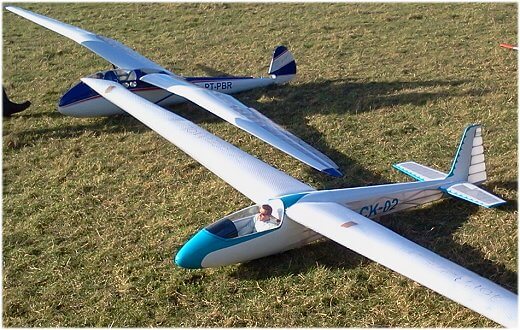
Well those are just several of the basic categories of rc gliders and sailplanes; as has already been mentioned radio control gliders have many many types, shapes and sizes from traditional built-up kits meant for relaxed soaring to modern carbon fiber racing machines capable of incredible speeds and performance.
Whichever type of rc glider you choose, you’ll be entering a hugely popular sector of the radio control flying hobby. The ease of control and gentle flying characteristics of many gliders make them a great attraction and introduction to the hobby, and I can highly recommend giving rc gliding a try especially if you live near an open slope that faces the prevailing wind!
So, then, radio control gliding is a hugely popular sector of the rc flying hobby with its dedicated followers, be they slope soarers or flat field flyers. Perfect for the beginner and advanced rc pilot alike, rc gliders and sailplanes will give you a truly rewarding experience.
From a personal point of view, rc gliders are my favourite form of radio control flight. They require very few accessories and there are no noise issues to worry about. In fact, the only real concern is whether or not your radio gear batteries will last as long as you want to fly for!
The challenge of having to seek out lift and use the air to keep your glider aloft, rather than just rely on motor power and thrust, is an addictive and exhilarating one. Why not give it a go?!

